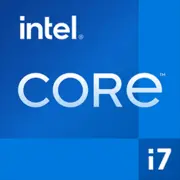Intel Core i7-1370P

Intel Core i7-1370P: Balancing Power and Mobility in 2025
Hybrid Architecture, Performance, and Use Cases for Premium Laptops
1. Architecture and Process: Hybrid Raptor Lake Approach
The Intel Core i7-1370P processor, built on the Raptor Lake architecture, continues Intel's tradition of hybrid solutions. Its structure includes two types of cores:
- 6 Performance-cores (P-cores) with Hyper-Threading support (12 threads) for resource-intensive tasks.
- 8 Efficient-cores (E-cores) (8 threads) for background processes and energy efficiency.
In total: 14 cores and 20 threads, providing flexibility in workload distribution. The base frequency is 1.9 GHz, with a maximum Turbo Boost frequency of up to 5.0 GHz for P-cores.
The Intel 7 (10nm Enhanced SuperFin) process is optimized to reduce power consumption without sacrificing performance. The integrated graphics Intel Iris Xe (96 EU) demonstrates improved performance: in games like CS:GO or Dota 2, it delivers 50-60 FPS on medium settings (1080p) and speeds up video rendering in DaVinci Resolve.
2. TDP 28W: Balancing Power and Battery Life
The 28W TDP positions the i7-1370P as a processor for thin ultrabooks and workstations. In comparison:
- U Series (15W): Weaker in multi-threaded tasks.
- H Series (45W): More powerful but requires substantial cooling.
The processor dynamically manages power consumption through Intel Dynamic Tuning Technology 3.0, adapting to workload. For example, when working in Excel, it reduces the frequency of E-cores to 1.2 GHz, saving battery charge, while in rendering mode, all cores operate at maximum capacity.
3. Performance: From Office to Gaming
Office Tasks:
- Launching 50+ tabs in Chrome + streaming — without lag.
- Working with large Excel spreadsheets (1 million rows) — instant responsiveness.
Multimedia:
- Exporting 4K video in Premiere Pro: 25% faster than the i7-1270P.
- Photo editing in Lightroom: 30-40% performance boost over the Tiger Lake generation.
Gaming:
- Genshin Impact at medium settings (1080p) — stable 45 FPS.
- Cyberpunk 2077 (with discrete RTX 4050) — 60 FPS in Full HD.
Turbo Mode: Under temporary loads (up to 30 seconds), the P-core frequency reaches 5.0 GHz, but in thin laptops, this may cause temperatures to rise to 95°C. For sustained workloads (e.g., rendering), the frequency stabilizes at 3.8-4.2 GHz.
4. Use Cases: Who Is the i7-1370P For?
- Professionals: Designers, programmers, data analysts.
- Students: Working with CAD applications and virtual machines.
- Travelers: Lightweight laptops (1.2-1.5 kg) with good battery life.
Not Suitable For:
- Hardcore gamers (who need an RTX 4080 or higher).
- Users requiring over 10 hours of battery life.
5. Battery Life: Technology vs. Appetite
With a TDP of 28W, laptop battery life varies:
- 6-8 hours: office tasks (brightness 50%, Wi-Fi).
- 3-4 hours: rendering or streaming.
Energy-Saving Technologies:
- Intel SpeedShift: Instant switching between C-state conditions.
- Adaptix™ Technology: AI-optimized core load.
Tip: Choose models with a battery of at least 70W·h (e.g., Dell XPS 15) — this can extend battery life up to 9 hours.
6. Comparison with Competitors
AMD Ryzen 7 7840U:
- Pros: Better battery life (up to 10 hours), 8 Zen 4 cores.
- Cons: Weaker in single-threaded tests (Geekbench 6: 2100 vs 2266).
Apple M3:
- Pros: 12-14 hours of work, ecosystem integration.
- Cons: Limited compatibility with Windows software.
Intel Core i7-1270P:
- Falls short in multi-threading (Geekbench 6 Multi: ~9500 vs 11476).
7. Pros and Cons of the Core i7-1370P
Strengths:
- Ideal for mobile workstations.
- Supports Thunderbolt 4 and PCIe 5.0.
- Best-in-class integration with Windows applications.
Weaknesses:
- Heating issues in compact cases (requires effective cooling system).
- Laptop prices: from $1400 (HP Spectre x360) to $2200 (Lenovo ThinkPad X1 Carbon).
8. How to Choose a Laptop with i7-1370P?
- Ultrabooks: ASUS ZenBook 14X (1.3 kg, 2.8K OLED display, $1500).
- Workstations: MSI Prestige 16 (16-inch display, 32 GB RAM, $1800).
What to Look For:
- Cooling system: at least two fans + heat pipes.
- Display: resolution of at least 1920x1200, 100% sRGB.
- Ports: 2x Thunderbolt 4 for connecting external GPUs.
9. Conclusion: Who Is the Processor Suitable For?
The Core i7-1370P is the choice for those needing a versatile laptop without compromises. It can handle video editing, complex analytics, and light gaming while maintaining portability. If your budget is $1400–$2000 and you value the balance between power and battery life, this processor will be a reliable partner until 2027. However, for gaming or extreme long battery life, it’s better to consider devices with discrete GPUs or Apple M3 chips.
Basic
CPU Specifications
Memory Specifications
GPU Specifications
Miscellaneous
Benchmarks
Compared to Other CPU
Share in social media
Or Link To Us
<a href="https://cputronic.com/cpu/intel-core-i7-1370p" target="_blank">Intel Core i7-1370P</a>